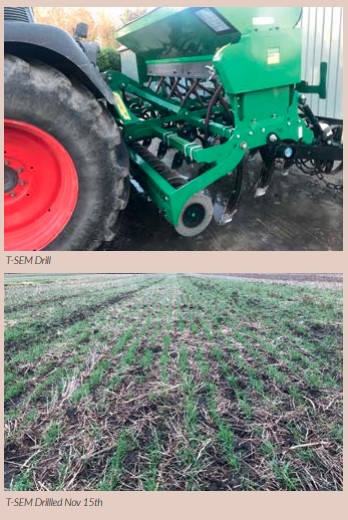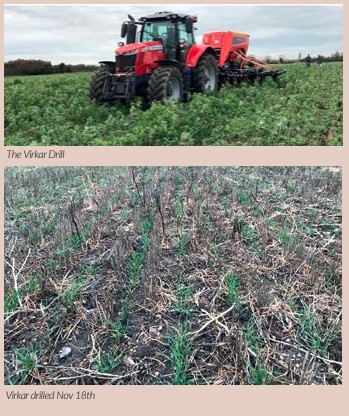
“It’s not about the machinery”, except once you get into cover crops and producing larger ones it is about machinery because without a drill that can cope with big volumes of vegetation cash crop establishment is compromised. An interesting video worth seeking out in the YouTube Horsch Live series showing on Feb 24th https://youtu. be/OoifwgXbEZ0 featured Julien Senez who talks of 4.5 ton biomass cover crops as being the target for adequate nutrition generation/recycling. Whether drilling green in the autumn or into early desiccated spring seedbeds this volume requires a cutting disc to avoid blockages. Another problem I have come across now I’m drilling second wheat is how you drill into big catch crops with an “understory” of wet chopped straw. Hair-pinning is always the worry and on soil that has been in Regen Ag for a few years with a residue build up in the top 50mm the soil is too soft to cut against. The question therefore arose is there a drill on the market (apart from a Cross Slot?) that would deal with big vegetation, much of which could be laying horizontal ie peas and vetch, and place seed cleanly through chopped straw.

To that end I had two drills on demo last autumn. The first was in fact the first direct drill I ever tried, the SimTech T-Sem. Hands up, five years ago I was on the bottom step of understanding direct drilling and what conditions are needed to achieve even establishment. Certainly a wet undulating stubble that had been previously Discordon’d and Vaderstad drilled was a long way from the firm level conditions I now have on the farm. Establishment across the drill was uneven due to wheelings and my lack of foresight to at least work at an angle didn’t help Lesson learnt, get your fields level in year one. Five years on this November the same drill has done a fabulous job with the slim feet causing minimal soil disturbance if used at a sensible speed with the tine vibration creating enough soil shatter to negate the need for harrowing or pressing over the rows. It did however struggle with an extreme amount of vegetation which may have been combated by pre rolling or it just being dryer! Score 8/10.
The second drill tried was the Virkar from Samagri. This is also a leading disc and tine drill which has many innovative features, and I’d urge you to check out the videos on Youtube. Used on the same high vegetation field as the T-Sem a few days earlier the pressure was on the guys doing the demo as I had invited a few other farmers to see the drill working. Again, we struggled with the high vegetation, soft soil surface and unwelcome shower and the finish could best be described as ugly, but the wheat now looks very well (see pics).

Again, I’d give a score of 8/10 but as the progress of neither drill on the day could have been described a “seamless” in these extreme conditions. I can’t say I’ve found a single drill to replace the need on this farm for a true disc and a pure tine drill. A solution could be to modify the type of cover grown to only include upright species and those that produce less bulk. Sadly, this would be a compromise as knowledgeable farmers (ie Julien mentioned earlier) much further along the journey of Regen Ag promote big volumes of vegetation. I also clearly remember Frédéric Thomas saying when asked at a meeting “you can’t have too much vegetation”. So for me for now its stick with two drills to have maximum flexibility without any compromises.
Experience with light disc “Joker” type machine.

The desire to be able to destroy covers by mechanical means without having to rely on frosts greater than -5 degrees led to me trialing a disc machine a few years ago. The principal worked well as ground conditions were reasonably dry that year in late November. Pluses for the technique were that the green matter was mixed into the top 50mm or so of topsoil to aid breakdown, feed the worms and importantly minimise the rate of glyphosate used. This proved to be successful as a single low rate was used to tidy up some small grass weeds predrilling.
So last summer I came across a very cheap new machine which was purchased and fitted with a small seed hopper to make its role flexible. Like a kid with a new toy I used it on several fields to establish catch crops pre winter wheat with the view to helping chit volunteer seed as well as establish the catch crop. It was operated at about 55mm deep and moved more soil than the Horsch CO that would have ordinarily been used. At the time I was satisfied with the job done however another wet autumn proved again less is more and right through until the end of Feb the moved ground walked wetter with the wheat crop looking less happy compared to where I’d left an unmoved control in the same field
Lesson learned, have faith and stick to the plan.
